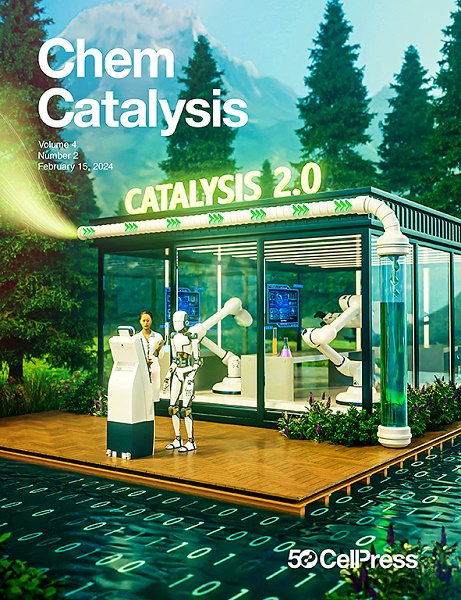Amine modification enables selective CO2 electroreduction to ethanol via coupling of carbon-containing intermediates
IF 11.6
Q1 CHEMISTRY, PHYSICAL
引用次数: 0
Abstract
Electrochemical CO2-to-ethanol conversion faces challenges due to competing ethylene formation. We demonstrate a strategy steering selectivity toward ethanol by modifying copper nanowires with N,N,N′,N′-tetramethylethylenediamine (TMe). The TMe-Cu catalyst achieved a remarkable ethanol faradaic efficiency of ∼58.8 at −0.97 V vs. RHE in H cells. Implementation in an alkaline flow electrolyzer yielded an ethanol partial current density of −216.2 mA cm−2. Combined experimental and computational analyses revealed that TMe modification creates an aerophilic-hydrophobic interface boosting CO2 adsorption and increasing ∗CO intermediate coverage on Cu active sites. In situ spectroscopic studies and controlled experiments identify an ethanol formation pathway involving asymmetric ∗CO–∗CHx coupling followed by ∗OCH2CH3 reduction, while completely suppressing ethylene generation. This work provides mechanistic insights into steering C–C coupling pathways through microenvironment engineering, offering a promising approach for sustainable multi-carbon alcohol synthesis from CO2.

胺改性使选择性二氧化碳电还原乙醇通过偶联的含碳中间体
电化学二氧化碳到乙醇的转化面临挑战,由于竞争的乙烯形成。我们展示了一种通过用N,N,N ',N ' -四亚甲基乙二胺(TMe)修饰铜纳米线来控制乙醇选择性的策略。与RHE相比,TMe-Cu催化剂在H细胞中在−0.97 V下获得了显著的乙醇法达化效率~ 58.8。在碱性流动电解槽中实现乙醇分电流密度为- 216.2 mA cm - 2。结合实验和计算分析表明,TMe修饰产生了一个亲氧-疏水界面,促进了CO2的吸附,增加了Cu活性位点上的∗CO中间体覆盖率。原位光谱研究和对照实验确定了乙醇形成途径,涉及不对称的∗CO -∗CHx偶联,然后是∗OCH2CH3还原,同时完全抑制乙烯的产生。这项工作提供了通过微环境工程指导C-C耦合途径的机制见解,为可持续地从CO2合成多碳醇提供了一种有前途的方法。
本文章由计算机程序翻译,如有差异,请以英文原文为准。
求助全文
约1分钟内获得全文
求助全文
来源期刊
CiteScore
10.50
自引率
6.40%
发文量
0
期刊介绍:
Chem Catalysis is a monthly journal that publishes innovative research on fundamental and applied catalysis, providing a platform for researchers across chemistry, chemical engineering, and related fields. It serves as a premier resource for scientists and engineers in academia and industry, covering heterogeneous, homogeneous, and biocatalysis. Emphasizing transformative methods and technologies, the journal aims to advance understanding, introduce novel catalysts, and connect fundamental insights to real-world applications for societal benefit.

 求助内容:
求助内容: 应助结果提醒方式:
应助结果提醒方式:


